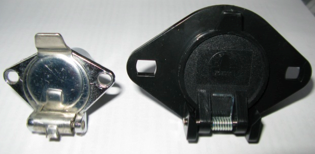4 Wire Versus 6 Wire Connections:
Q: When we are setting up a vehicle for towing we often hear: You recommend 6 wire connectors. The
other dealer specified a four wire connector. What gives?
A: Most towed vehicles require 4 wires for their lighting requirements however there are other power requirements. The lighting is as follows: (with the color code in brackets):
Right Signal and Brake (green),
Left Signal & Brake, (yellow)
Tail‐lights (brown)
and Ground (white).
The majority of wiring kits include what is known in the industry as flat four trailer wiring which is a flat cable with four colored wires moulded into a single strip. (See photo)
For a vehicle lighting requirements and for light‐weight utility trailers that do not have electric brakes, this type of wiring is fine. It was adopted by the RV industry when RVers first decided to tow small cars about twenty years ago.
Needs have changed:
Today, towing systems are more sophisticated with most RVers regularly towing a vehicle equipped with a Towed Vehicle Braking system. Some even require a charge line. With Four Wire connectors, you are out of connections. For this reason six wire connectors are the industry norm today. Another reason to
adopt a six wire system is that the type and quality of connectors is vastly superior. As the two photos show, the black six wire connector is far more substantial with larger pins capable of carrying higher current loads
than the smaller chrome four wire connectors.
The six wire connector is polarized so that the plug in part can only go in one way, even if forced into place. There is better water infiltration protection from a large boot rather than a grommet.
The RV industry has acknowledged that RVers may tow a larger trailer or a Towed Vehicle behind what are much larger RV’s than were the norm 20 years ago. The industry has
adopted a standardized seven pin blade style receptacle (see photo) so that trailers, which come with male ends designed to mate to these connectors, can be plugged right in.
All the lighting, braking and charge wiring is accommodated with a seven pin blade connector. Towed Vehicles usually do not require a charge line, so one wire connection can be eliminated and six wires will provide all the functionality required. The industry has responded with a round plug in adapter, which can be readily obtained. It is simply plugged into the coach connector and the cable extension is plugged into it, to provide all the functionality required. (See Photos)
Should a Charge line be required, many adapters have the capability of allowing one
wire to be moved to provide 12 volts from the Coach connector to the tow car.
RV manufacturers frequently use relays for all of the lighting functions to ensure that full power is available to the trailer or Towed Vehicle. This, when combined with a much more substantial connector, means the lighting on the towed vehicle is brighter and will be clearly visible under all towing conditions.
The Extension cable between the RV and the Towed Vehicle should be a coiled style to greatly reduce the risk of it being damaged when turning or crossing uneven terrain. The cable will stretch out or contract depending upon the need and should never drag on the ground or get caught under the tow system. This style of cable also allows for Drop/Riser receivers and other towing accessories to be installed in the towing system while maintaining the wiring above the tow system.
Conclusion: Always Go with the 6 Wire Tow Electrical Connections.
(This post is also available in an easy to read PDF format. Contact Us and ask for this Tech Tweet by telling us that you would like a copy of the Tech Tweet "What Type of Wiring Should I Use?")
---
Like what you've just read?
Tell your friends on facebook or twitter!
Tweet











No comments:
Post a Comment